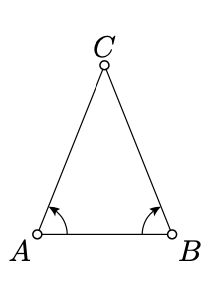4.3: Triángulos de isóselas
- Page ID
- 114617
Un triángulo con dos lados iguales se llama isósceles; el lado restante se llama base.
Supongamos que\(\triangle ABC\) es un triángulo isósceles con la base\([AB]\). Entonces
\(\measuredangle ABC \equiv - \measuredangle BAC.\)
Además, lo contrario se mantiene si no\(\triangle ABC\) es degenerado.
La siguiente prueba se debe a Pappus de Alejandría.
- Prueba
-

Tenga en cuenta que
\(CA = CB\),\(CB = CA\),\(\measuredangle ACB \equiv -\measuredangle BCA\).
Por Axioma IV,
\(\triangle CAB \cong \triangle CBA.\)
Aplicando el teorema sobre los signos de ángulos de triángulos (Teorema 3.3.1) Y Axioma IV de nuevo, obtenemos que
\(\measuredangle BAC \equiv -\measuredangle ABC.\)
Para probar lo contrario, asumimos eso\(\measuredangle CAB \equiv - \measuredangle CBA\). Por condición ASA (Teorema 4.2.1),\(\triangle CAB \cong \triangle CBA\). Por lo tanto,\(CA = CB\).
Un triángulo con tres lados iguales se llama equilátero.
Ejercicio\(\PageIndex{1}\)
Dejar\(\triangle ABC\) ser un triángulo equilátero. Demostrar que
\(\measuredangle ABC = \measuredangle BCA = \measuredangle CAB.\)
- Sugerencia
-
Aplicar Teorema 4.3.1 dos veces


